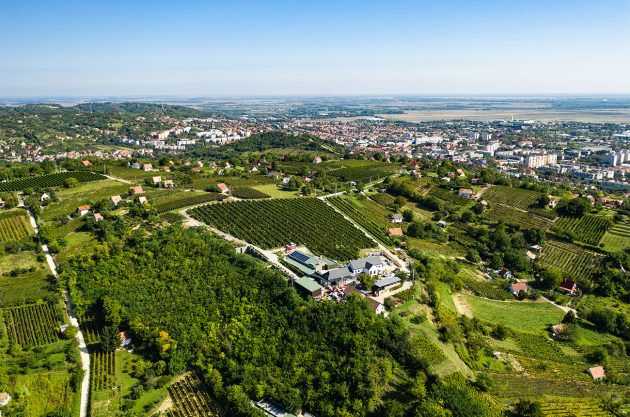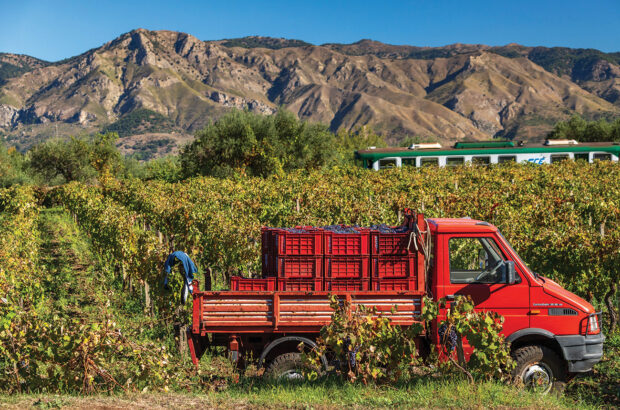First created in the 19th century, Bikavér – ‘bull’s blood’ – is Hungary’s most renowned red blend, produced in Eger and Szekszárd.
The Hungarian name ‘bika (bull) – vér (blood)’ gives up the first hint about the colour of Hungary’s iconic red wine: legend has it that during the Ottoman invasion in 1552, Hungarian soldiers drank dark-coloured red wine to fortify themselves while defending the Eger castle against the Turkish siege. The blood-like red wine stains on their clothes and faces caused rumours among the tee-total Turks that the Hungarian soldiers were drinking bull’s blood to gain power, hence the birth of the name ‘Bikavér’.
As fascinating as it sounds, the legend is unlikely to be true, primarily because Hungary was largely a white wine-producing country in the 16th century. It was only after Phylloxera had rampaged through the vineyards in the 1880s that growers in certain regions started to replant their vineyards with red grapes.
{"content":"PC9wPgo8aDI+QmlrYXbDqXI6IEtleSByZWdpb25zPC9oMj4KPHA+RWdlciBpbiB0aGUgbm9ydGggYW5kIFN6ZWtzesOhcmQgaW4gdGhlIHNvdXRoIG9mIEh1bmdhcnkgYXJlIHRoZSBvbmx5IHR3byByZWdpb25zIGRlc2lnbmF0ZWQgdG8gcHJvZHVjZSB0aGUgZmFtb3VzIHJlZCBibGVuZCBhbmQgdG8gdXNlIHRoZSB0ZXJtIOKAmEJpa2F2w6ly4oCZIG9uIHRoZSBsYWJlbC48L3A+CjxwPjxkaXYgY2xhc3M9ImFkLWNvbnRhaW5lciBhZC1jb250YWluZXItLW1vYmlsZSI+PGRpdiBpZD0icG9zdC1pbmxpbmUtMiIgY2xhc3M9ImlwYy1hZHZlcnQiPjwvZGl2PjwvZGl2PjwvcD4KPHA+4oCYVGhlcmUgYXJlIGZhciBtb3JlIGRpZmZlcmVuY2VzIHRoYW4gc2ltaWxhcml0aWVzIGJldHdlZW4gdGhlIHR3byByZWdpb25zLOKAmSBzYWlkIEVsaXphYmV0aCBHYWJheSBNVyBkdXJpbmcgdGhlIDIwMjIgSHVuZ2FyaWFuIFdpbmUgU3VtbWl0LjwvcD4KPGgzPjxzdHJvbmc+RWdlcjwvc3Ryb25nPjwvaDM+CjxwPk9ubHkgdHdvIGhvdXJz4oCZIGRyaXZlIGZyb20gVG9rYWosIEVnZXIgaXMgYSBjb29sLWNsaW1hdGUgcmVnaW9uIG9uIGEgc2ltaWxhciBsYXRpdHVkZSB0byBCdXJndW5keS4gV2l0aCB0aGUgQsO8a2sgbW91bnRhaW5zIHRvIHRoZSBlYXN0LCB2b2xjYW5pYyBzb2lscyBkb21pbmF0ZSBpdHMgNSw1MDBoYSBvZiB2aW5leWFyZHMuIEFtb25nIHRoZSByZWdpb27igJlzIHNpbmdsZS12aW5leWFyZCBzaXRlcyBpcyBOYWd5LUVnZWQtaGVneSwgdGhlIGhpZ2hlc3QgdmluZXlhcmQgaW4gSHVuZ2FyeSBhdCBvdmVyIDUzMCBtZXRyZXMgYWJvdmUgc2VhIGxldmVsLjwvcD4KPHA+VGhlIGZpcnN0IOKAmG9mZmljaWFs4oCZIEVncmkgQmlrYXbDqXIgd2FzIG1hZGUgaW4gMTg2OCBieSBKZXdpc2ggYnVzaW5lc3NtYW4gTGlwb3QgS2FuaXR6LCB3aG8gd2FzIHJlc3BvbnNpYmxlIGZvciByZXN0b3JpbmcgdGhlIGxvY2FsIHdpbmUgaW5kdXN0cnkgaW4gdGhlIHBvc3QtUGh5bGxveGVyYSBlcmEgYW5kIGdhaW5pbmcgYW4gaW50ZXJuYXRpb25hbCByZWNvZ25pdGlvbiBmb3IgaXRzIHdpbmVzPC9wPgo8ZGl2IGNsYXNzPSJhZC1jb250YWluZXIgYWQtY29udGFpbmVyLS1tb2JpbGUiPjxkaXYgaWQ9InBvc3QtaW5saW5lLTMiIGNsYXNzPSJpcGMtYWR2ZXJ0Ij48L2Rpdj48L2Rpdj4KPGRpdiBpZD0iYXR0YWNobWVudF80ODA4NzciIHN0eWxlPSJ3aWR0aDogNjQwcHgiIGNsYXNzPSJ3cC1jYXB0aW9uIGFsaWduY2VudGVyIj48aW1nIGZldGNocHJpb3JpdHk9ImhpZ2giIGRlY29kaW5nPSJhc3luYyIgYXJpYS1kZXNjcmliZWRieT0iY2FwdGlvbi1hdHRhY2htZW50LTQ4MDg3NyIgY2xhc3M9Imxhenlsb2FkIGJsdXItdXAgd3AtaW1hZ2UtNDgwODc3IHNpemUtbGFyZ2UiIGRhdGEtcHJvY2Vzc2VkIHNyYz0iaHR0cHM6Ly93d3cuZGVjYW50ZXIuY29tL3dwLWNvbnRlbnQvdGhlbWVzL3NpbWJhLXRoZW1lL2Fzc2V0cy9pbWFnZXMvcGxhY2Vob2xkZXIucG5nIiBkYXRhLXNyYz0iaHR0cHM6Ly9rZXlhc3NldHMudGltZWluY3VrLm5ldC9pbnNwaXJld3AvbGl2ZS93cC1jb250ZW50L3VwbG9hZHMvc2l0ZXMvMzQvMjAyMi8wNS9FZ2VyLXdpbmUtZGlzdHJpY3QtNjMweDQxNy5qcGciIGFsdD0iVGhlIEVnZXIgd2luZSBkaXN0cmljdCBpbiBIdW5nYXJ5IiB3aWR0aD0iNjMwIiBoZWlnaHQ9IjQxNyIgZGF0YS1zaXplcz0iYXV0byIgZGF0YS1zcmNzZXQ9Imh0dHBzOi8va2V5YXNzZXRzLnRpbWVpbmN1ay5uZXQvaW5zcGlyZXdwL2xpdmUvd3AtY29udGVudC91cGxvYWRzL3NpdGVzLzM0LzIwMjIvMDUvRWdlci13aW5lLWRpc3RyaWN0LTYzMHg0MTcuanBnIDYzMHcsIGh0dHBzOi8va2V5YXNzZXRzLnRpbWVpbmN1ay5uZXQvaW5zcGlyZXdwL2xpdmUvd3AtY29udGVudC91cGxvYWRzL3NpdGVzLzM0LzIwMjIvMDUvRWdlci13aW5lLWRpc3RyaWN0LTMwMHgxOTguanBnIDMwMHcsIGh0dHBzOi8va2V5YXNzZXRzLnRpbWVpbmN1ay5uZXQvaW5zcGlyZXdwL2xpdmUvd3AtY29udGVudC91cGxvYWRzL3NpdGVzLzM0LzIwMjIvMDUvRWdlci13aW5lLWRpc3RyaWN0LTEzNXg4OS5qcGcgMTM1dywgaHR0cHM6Ly9rZXlhc3NldHMudGltZWluY3VrLm5ldC9pbnNwaXJld3AvbGl2ZS93cC1jb250ZW50L3VwbG9hZHMvc2l0ZXMvMzQvMjAyMi8wNS9FZ2VyLXdpbmUtZGlzdHJpY3QtMzIweDIxMi5qcGcgMzIwdywgaHR0cHM6Ly9rZXlhc3NldHMudGltZWluY3VrLm5ldC9pbnNwaXJld3AvbGl2ZS93cC1jb250ZW50L3VwbG9hZHMvc2l0ZXMvMzQvMjAyMi8wNS9FZ2VyLXdpbmUtZGlzdHJpY3QtNjIweDQxMC5qcGcgNjIwdywgaHR0cHM6Ly9rZXlhc3NldHMudGltZWluY3VrLm5ldC9pbnNwaXJld3AvbGl2ZS93cC1jb250ZW50L3VwbG9hZHMvc2l0ZXMvMzQvMjAyMi8wNS9FZ2VyLXdpbmUtZGlzdHJpY3QtOTIweDYwOS5qcGcgOTIwdywgaHR0cHM6Ly9rZXlhc3NldHMudGltZWluY3VrLm5ldC9pbnNwaXJld3AvbGl2ZS93cC1jb250ZW50L3VwbG9hZHMvc2l0ZXMvMzQvMjAyMi8wNS9FZ2VyLXdpbmUtZGlzdHJpY3QtMTIyMHg4MDcuanBnIDEyMjB3LCBodHRwczovL2tleWFzc2V0cy50aW1laW5jdWsubmV0L2luc3BpcmV3cC9saXZlL3dwLWNvbnRlbnQvdXBsb2Fkcy9zaXRlcy8zNC8yMDIyLzA1L0VnZXItd2luZS1kaXN0cmljdC5qcGcgMTMwMHciIHNpemVzPSIobWF4LXdpZHRoOiA2MzBweCkgMTAwdncsIDYzMHB4IiAvPjxwIGlkPSJjYXB0aW9uLWF0dGFjaG1lbnQtNDgwODc3IiBjbGFzcz0id3AtY2FwdGlvbi10ZXh0Ij5UaGUgRWdlciB3aW5lIGRpc3RyaWN0LiBDcmVkaXQ6IFdpbmVzIG9mIEh1bmdhcnkgUGVyc29uYWxseTwvcD48L2Rpdj4KPGgzPjxzdHJvbmc+U3pla3N6w6FyZDwvc3Ryb25nPjwvaDM+CjxkaXYgY2xhc3M9ImluamVjdGlvbiI+PC9kaXY+CjxwPlN6ZWtzesOhcmQgaXMgaW4gdGhlIFBhbm5vbiByZWdpb24gb2Ygc291dGhlcm4gSHVuZ2FyeSwgbG9jYXRlZCB3ZXN0IG9mIHRoZSByaXZlciBEYW51YmUuwqBUaGUgcmVnaW9u4oCZcyAyLDEwMGhhIG9mIHZpbmVzIGFyZSBwbGFudGVkIG9uIGEgY29tcGxleCBwYXRjaHdvcmsgb2YgZGlmZmVyZW50IG9yaWVudGF0aW9ucyBhbmQgYWx0aXR1ZGVzLCB3aXRoIGxvZXNzIGFuZCBjaGFsa3kgbGltZXN0b25lIHNvaWxzIGRvbWluYXRpbmcgaXRzIHZpbmV5YXJkcy48L3A+CjxkaXYgY2xhc3M9ImFkLWNvbnRhaW5lciBhZC1jb250YWluZXItLW1vYmlsZSI+PGRpdiBpZD0icG9zdC1pbmxpbmUtNCIgY2xhc3M9ImlwYy1hZHZlcnQiPjwvZGl2PjwvZGl2Pgo8cD5TemVrc3rDoXJkaSBwb2V0IErDoW5vcyBHYXJheSBmaXJzdCBtZW50aW9uZWQg4oCYQnVsbOKAmXMgQmxvb2TigJkgaW4gaGlzIHBvZW0sICYjODIxNjtTemVnc3rDoXJkaSBCb3JkYWwmIzgyMTc7LCBpbiAxODQ2LjwvcD4KPGRpdiBjbGFzcz0ibWNlVGVtcCI+Cg=="}

The Szekszárd wine district. Credit: Wines of Hungary Personally
The Bull’s Blood wine blend
Bikavér (‘bull’s blood’) usually includes a minimum of four varieties:
Kékfrankos
Kékfrankos (aka Blaufränkisch) is the soul of Bikavér and perhaps the only constant in what can be a diverse blend. Taking the top place in Hungary’s red grape plantings, the variety’s sturdiness, its ability to reflect the terroir and retain acidity even in hotter years are especially treasured by Hungarian winemakers, according to Caroline Gilby MW, a wine writer and judge specialising in Central and Eastern European wines.
Kékfrankos must make up at least 30% of Egri Bikavér, while 45% and above is necessary for the Szekszárdi version. The warmer climate of Szekszárd doesn’t necessarily lead to heavier and jammier wines, explained Gabay – the higher minimum percentages of Kékfrankos means that Szekszárdi Bikavér may actually appear lighter and fresher than its Egri peer.
In a warm vintage such as 2017, when the Bordeaux varieties are building up alcohol, ‘Kékfrankos can take it [the alcohol levels] back, so you still get moderate alcohol levels in the final blend,’ explained Csilla Sebestyén of Sebestyén Winery in Szekszárd.
Kadarka
The thin-skinned Kadarka used to play a far more important part in the blend but as it’s prone to disease and ripens too late, the grape is now largely replaced by Kékfrankos in Hungary, with small areas of plantings carefully managed by winegrowers in Szekszárd. A small percentage of Kadarka (5-10% ) is mandatory for Egri Szekszárdi.
Other varieties
Classic Bordeaux varieties, namely Cabernet Sauvignon, Cabernet Franc and Merlot, are also common candidates in Bikavér, contributing tannic structure and fruit favours.
Other permitted grapes include local varieties such as Zweigelt and Portugieser, in addition to international varieties such as Pinot Noir and Syrah.

The Kékfrankos grape is the soul of Bikavér. Credit: Wines of Hungary Personally
For many, the name Bikavér may still ‘conjure up memories of cheap and rustic wine,’ said Gilby. This is mainly due to the reputation of mass-produced, low quality reds exported during the Communist era.
According to Tibor Gál of Gál Tibor Winery in Eger, however, in the last five years ‘more [changes have] happened to both Bikavér regions than the last 170 years.’ Increasingly, the younger generation of Hungarian winemakers are making their Bikavér with a more gentle approach, followed by ageing for a much shorter period than their grandparents’ generation. The aim, said Gál, is to make ‘fresher and more contemporary’ wines, from easy-drinking food wines to refined single-vineyard editions capable of ageing for decades.
Bikavér ageing requirements
To make Kékfrankos-driven ‘Bull’s Blood’ wine, ageing in oak is a must for both Egri and Szekszárdi versions, and both have their own quality categories:
Egri Bikavér has three ageing criteria, starting with Classicus (six months in oak), then Superior (12 months), and finally Grand Superior (16 months).
There are only two categories for Szekszárdi Bikavér; Regular and Premium, both demanding at least a year of ageing in barrel. To qualify as Premium, the wine must meet further restrictions, including lower maximum yields.














